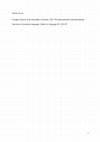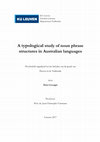Papers by Dana Louagie

Linguistics, 2022
This article develops foundations for a new typology of nominal expressions. Despite the signific... more This article develops foundations for a new typology of nominal expressions. Despite the significant diversity attested in languages around the world, a view traditionally and sometimes still found holds that languages either have 'classic', rigidly structured noun phrases (NPs) or lack them. A simple dichotomy, however, does not adequately represent the significant language-internal and crosslinguistic diversity of forms and functions of nominal expressions. While many linguists may not in fact think in such binary terms, a comprehensive typology is still wanting. This article offers foundations towards such a typology, with a particular emphasis on language-internal diversity. This diversity within languages has received little attention in previous studies, even while it reveals much about the actual complexity in the nominal domain. Besides surveying structural types and their motivating factors across as well as within languages from around the world, this article approaches nominal expressions also from a variety of other perspectives to enrich our understanding of them. This includes approaching nominal expressions from the perspective of word class systems as well as diachronically. We round off the article by looking at the impact of orality-literacy dimensions and communicative modes.
Australian languages generally lack a part of speech with typical determiner features such as obl... more Australian languages generally lack a part of speech with typical determiner features such as obligatory use, competition for a specific position in the noun phrase and specialization in this function. This study uses a sample of 100 languages to investigate whether Australian languages can be said to have any kind of determiner system, and if so, what it looks like in structural terms. I show that there is structural
evidence for a determiner slot or zone in half of the languages. Parts of speech occurring in these slots/zones are often non-specific, also used in other functions in the NP. This offers an interesting window on the semantics of determiners, as it allows us to contrast determiner uses with non-determiner ones.
This paper examines whether Australian languages generally lack clear noun phrase structures, as ... more This paper examines whether Australian languages generally lack clear noun phrase structures, as has sometimes been argued in the literature. We break up the notion of NP constituency into a set of concrete typological parameters, and analyse these across a sample of 100 languages, representing a significant portion of diversity on the Australian continent. We show that there is little evidence to support general ideas about the absence of NP structures, and we argue that it makes more sense to typologize languages on the basis of where and how they allow ‘classic’ NP construal, and how this fits into the broader range of construals in the nominal domain.

This paper analyses the adnominal use of personal pronouns in a sample of 75 Australian languages... more This paper analyses the adnominal use of personal pronouns in a sample of 75 Australian languages. We develop two arguments. First, we argue that in all of the adnominal uses examined, the personal pronoun has a determiner-like function, showing both the functional properties and some of the behaviour of more typical determiner categories like demonstratives or articles. We support this analysis with evidence from positioning tendencies, semantics and discourse functions, and indications of grammaticization in some languages. Secondly, we show that this phenomenon is relatively widespread in Australia, occurring in about half of the languages examined here. We identify five potential geographic clusters, one or two of which can be analysed as areally determined groupings around a centre with incipient grammaticization. From a typological perspective, these data present new evidence for a somewhat under-studied pathway to nominal determination, in addition to better-studied pathways involving demonstratives, numerals or adjectives.
Thesis Chapters by Dana Louagie

This dissertation presents a general analysis of noun phrase (NP) structures in Australian langua... more This dissertation presents a general analysis of noun phrase (NP) structures in Australian languages. I use a sample of 100 Australian languages, which represents about 40% of all Australian languages at first contact, and about 65% of all Australian languages for which relatively detailed descriptions are available. The analysis is developed in two main parts, each with a different aim and focus.
The first part of the dissertation presents a general survey of NP features. In this survey, I try to develop a synthesis of the available Australianist literature, testing some of the ideas from the literature on the languages of my sample, and showing where Australian languages stand in relation to other languages in the world. The survey consists of three chapters, with domains grouped together on the basis of how well they have been described in the literature. Chapter 1 deals with nominal classification, which is the best-described aspect of NP structure for Australian languages. Chapter 2 discusses the domains of qualification and quantification, which have received some attention in the literature, but not to the same extent as classification. Chapter 3 introduces the domains of determination and NP constituency, which are most poorly understood, due to a general lack of attention in the case of determination, and a failure to test wide-ranging claims in the case of constituency.
The second part of the dissertation then takes up the last two aspects, determination and NP constituency, for more detailed analysis. Chapter 4 deals with the question of NP constituency, which is a rather problematic issue in the available literature. On the basis of my sample, I show that the idea that Australian languages tend to lack clear phrasal structure is over-stated. I suggest an alternative approach to the question of NP constituency, and argue that it is more interesting to typologise languages on the basis of where and how they allow phrasal structure rather than on the basis of a simple yes-no answer to the question of NP constituency. This alternative approach is followed up in an analysis of discontinuous structures. Chapter 5, finally, investigates the domain of NP determination, which is overall the least well-studied aspect of NP structure for Australian languages. Within this domain, I focus on the syntactic status of determining elements. Australian languages generally lack ‘classic’ determiner features, like obligatory use in particular (e.g. definite) contexts or a restriction to one determiner for each NP. I show that there is good evidence to identify a determiner slot in approximately half of the languages of the sample, and I discuss which types of elements tend to occur in these slots, including some less well-studied ones like personal pronouns and quantifiers.
Conference Presentations by Dana Louagie
Introduction 2 (1) Kalkatungu (Kalkatungic) a. cipa-yi t̪ uku-yu yaun-tu yaɲi icayi this-ERG dog-... more Introduction 2 (1) Kalkatungu (Kalkatungic) a. cipa-yi t̪ uku-yu yaun-tu yaɲi icayi this-ERG dog-ERG big-ERG white-man bite 'This big dog bit/bites the white man.' (Blake 1983: 45) b
Books by Dana Louagie

Mouton de Gruyter, 2020
This book presents a first comprehensive typological analysis of noun phrases in Australian langu... more This book presents a first comprehensive typological analysis of noun phrases in Australian languages, covering the domains of classification, qualification, quantification, determination and constituency. The analysis is based on a representative sample of 100 languages. Among other points, the results call into question the classic idea that Australian languages tend to lack phrasal structures in the nominal domain, with over two thirds of the languages showing evidence for phrasehood. Moreover, it is argued that it may be more interesting to typologise languages on the basis of where and how they allow phrasal structure, rather than on the basis of a yes-no answer to the question of constituency. The analysis also shows that a determiner slot can be identified in about half of the languages, even though they generally lack 'classic' determiner features like obligatory use in particular contexts or a restriction to one determiner per NP. Special attention is given to elements, which can be used both inside and beyond determiner slots, demonstrating how part of speech and functional structure do not always align. The book is of interest to researchers documenting Australian languages, as well as to typologists and theorists.
Drafts by Dana Louagie

Word classes in Australian languages
In: Eva van Lier (ed.), Oxford Handbook of Word Classes, 2020
This chapter discusses word classes in Australian languages, covering the large Pama-Nyungan fami... more This chapter discusses word classes in Australian languages, covering the large Pama-Nyungan family as well as several smaller families. Australian languages are often described as generally lacking a noun-adjective distinction. This is true for part of the languages: they have a flexible class of nominals that can function both referentially and attributively. Other languages, however, have a distinct adjective class, which in some languages is both morphologically and distributionally defined, and in others only distributionally (e.g. by their position in the NP). Verbs, by contrast, are generally a clearly distinct class on morphosyntactic grounds, with minor morphological overlap with other parts of speech. In fact, several northern languages have two verbal word classes, viz. inflecting verbs and uninflecting verbs, which serve different predicational (and other) functions. Manner adverbs, finally, are also a distinct word class in most languages, although they may show morphological similarities with nominals (e.g. case marking) or verbs (e.g. TAM marking). Only some languages have lexemes that are flexible between adverbial and adjectival functions.
-- To appear in the Oxford Handbook of Word Classes, Eva van Lier (ed.) --

Demonstratives in Australian languages
In: Claire Bowern (ed.), Oxford Handbook of Australian languages , 2019
This chapter provides a survey of demonstratives in Australian languages. It discusses their morp... more This chapter provides a survey of demonstratives in Australian languages. It discusses their morphosyntax, semantic and pragmatic functions, and potential grammaticalisation pathways, in relation to findings and questions from the general typological literature. Morphosyntactically, the focus is on their distribution across pronominal, adnominal, adverbial and identifying contexts, their inflectional possibilities, and their relation to other determining elements in nominal expressions. Semantically, I show that, while some Australian languages have simple systems of two or three demonstratives which can be used in a range of contexts, others have very complex and intricate systems, with a range of demonstratives each having specific spatial, non-spatial, anaphoric, recognitional and/or other senses. Finally, I make some observations on (signs of) grammaticalisation into definite markers, personal pronouns or relative pronouns.
-- To appear in Oxford Handbook of Australian Languages, Claire Bowern (ed.) --

The Noun Phrase in Australian languages
In: Claire Bowern (ed.), Oxford Handbook of Australian languages, 2019
Australian languages are regularly described as not having NPs in the classic sense, but rather l... more Australian languages are regularly described as not having NPs in the classic sense, but rather loosely ordered expressions that are merely associated in terms of joint reference. This chapter shows that these languages exhibit more diversity in the nominal domain than is sometimes assumed in the literature, and focuses on two points which can be regarded as defining for NPs: syntactic unithood and the presence of determiners. Moreover, the chapter also argues for a different perspective in dealing with the nominal domain, viz. to typologise languages in terms of the full range of structural possibilities they have available instead of on the basis of a simple yes/no question about the presence of NPs. The same goes for determiners, where the focus should not just be on specialised determiners, but also on elements that can switch between different functions.
-- To appear in Oxford Handbook of Australian Languages, Claire Bowern (ed.) --









Uploads
Papers by Dana Louagie
evidence for a determiner slot or zone in half of the languages. Parts of speech occurring in these slots/zones are often non-specific, also used in other functions in the NP. This offers an interesting window on the semantics of determiners, as it allows us to contrast determiner uses with non-determiner ones.
Thesis Chapters by Dana Louagie
The first part of the dissertation presents a general survey of NP features. In this survey, I try to develop a synthesis of the available Australianist literature, testing some of the ideas from the literature on the languages of my sample, and showing where Australian languages stand in relation to other languages in the world. The survey consists of three chapters, with domains grouped together on the basis of how well they have been described in the literature. Chapter 1 deals with nominal classification, which is the best-described aspect of NP structure for Australian languages. Chapter 2 discusses the domains of qualification and quantification, which have received some attention in the literature, but not to the same extent as classification. Chapter 3 introduces the domains of determination and NP constituency, which are most poorly understood, due to a general lack of attention in the case of determination, and a failure to test wide-ranging claims in the case of constituency.
The second part of the dissertation then takes up the last two aspects, determination and NP constituency, for more detailed analysis. Chapter 4 deals with the question of NP constituency, which is a rather problematic issue in the available literature. On the basis of my sample, I show that the idea that Australian languages tend to lack clear phrasal structure is over-stated. I suggest an alternative approach to the question of NP constituency, and argue that it is more interesting to typologise languages on the basis of where and how they allow phrasal structure rather than on the basis of a simple yes-no answer to the question of NP constituency. This alternative approach is followed up in an analysis of discontinuous structures. Chapter 5, finally, investigates the domain of NP determination, which is overall the least well-studied aspect of NP structure for Australian languages. Within this domain, I focus on the syntactic status of determining elements. Australian languages generally lack ‘classic’ determiner features, like obligatory use in particular (e.g. definite) contexts or a restriction to one determiner for each NP. I show that there is good evidence to identify a determiner slot in approximately half of the languages of the sample, and I discuss which types of elements tend to occur in these slots, including some less well-studied ones like personal pronouns and quantifiers.
Conference Presentations by Dana Louagie
Books by Dana Louagie
Drafts by Dana Louagie
-- To appear in the Oxford Handbook of Word Classes, Eva van Lier (ed.) --
-- To appear in Oxford Handbook of Australian Languages, Claire Bowern (ed.) --
-- To appear in Oxford Handbook of Australian Languages, Claire Bowern (ed.) --
evidence for a determiner slot or zone in half of the languages. Parts of speech occurring in these slots/zones are often non-specific, also used in other functions in the NP. This offers an interesting window on the semantics of determiners, as it allows us to contrast determiner uses with non-determiner ones.
The first part of the dissertation presents a general survey of NP features. In this survey, I try to develop a synthesis of the available Australianist literature, testing some of the ideas from the literature on the languages of my sample, and showing where Australian languages stand in relation to other languages in the world. The survey consists of three chapters, with domains grouped together on the basis of how well they have been described in the literature. Chapter 1 deals with nominal classification, which is the best-described aspect of NP structure for Australian languages. Chapter 2 discusses the domains of qualification and quantification, which have received some attention in the literature, but not to the same extent as classification. Chapter 3 introduces the domains of determination and NP constituency, which are most poorly understood, due to a general lack of attention in the case of determination, and a failure to test wide-ranging claims in the case of constituency.
The second part of the dissertation then takes up the last two aspects, determination and NP constituency, for more detailed analysis. Chapter 4 deals with the question of NP constituency, which is a rather problematic issue in the available literature. On the basis of my sample, I show that the idea that Australian languages tend to lack clear phrasal structure is over-stated. I suggest an alternative approach to the question of NP constituency, and argue that it is more interesting to typologise languages on the basis of where and how they allow phrasal structure rather than on the basis of a simple yes-no answer to the question of NP constituency. This alternative approach is followed up in an analysis of discontinuous structures. Chapter 5, finally, investigates the domain of NP determination, which is overall the least well-studied aspect of NP structure for Australian languages. Within this domain, I focus on the syntactic status of determining elements. Australian languages generally lack ‘classic’ determiner features, like obligatory use in particular (e.g. definite) contexts or a restriction to one determiner for each NP. I show that there is good evidence to identify a determiner slot in approximately half of the languages of the sample, and I discuss which types of elements tend to occur in these slots, including some less well-studied ones like personal pronouns and quantifiers.
-- To appear in the Oxford Handbook of Word Classes, Eva van Lier (ed.) --
-- To appear in Oxford Handbook of Australian Languages, Claire Bowern (ed.) --
-- To appear in Oxford Handbook of Australian Languages, Claire Bowern (ed.) --